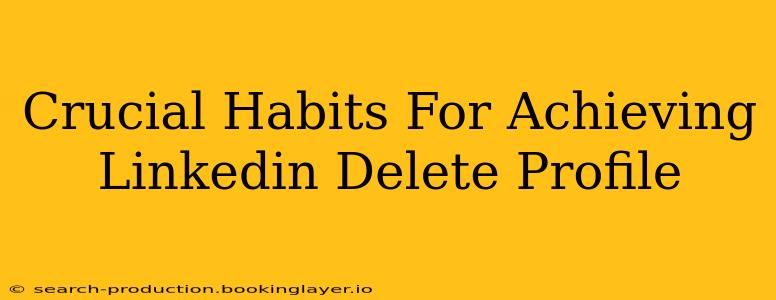Are you ready to say goodbye to LinkedIn? Perhaps you've landed your dream job, are focusing on a different platform, or simply want a digital detox. Whatever your reason, deleting your LinkedIn profile can feel like a daunting task. This guide outlines crucial habits to help you successfully and permanently delete your LinkedIn profile.
Understanding the LinkedIn Deletion Process
Before diving into the habits, it's vital to understand how LinkedIn allows you to delete your profile. It's not a simple one-click process. LinkedIn encourages users to deactivate their profiles instead, which allows for reactivation at any time. To achieve complete deletion, you need to actively request it through their system. This often involves navigating menus and confirming your choice multiple times.
Key Steps to Remember:
- Understand the difference between deactivation and deletion: Deactivation hides your profile; deletion permanently removes it.
- Backup your data: Before initiating the deletion process, download a copy of your profile information, recommendations, and connections. LinkedIn provides a way to do this.
- Review your connections: Let your close professional contacts know you're deleting your profile, especially if you're using LinkedIn for networking.
Cultivating the Right Habits for Successful Deletion
Successfully deleting your LinkedIn profile requires more than just clicking buttons. It demands a strategic approach and consistent effort. Here are some crucial habits to adopt:
1. Plan Your Deletion:
Don't impulsively delete your profile. Schedule a time to complete the process when you're not rushed or distracted. This allows you to carefully follow all the steps and avoid accidental errors. Treat it like any other important task requiring your full attention.
2. Prepare Your Alternatives:
If you're deleting your LinkedIn profile for professional reasons (e.g., focusing on another platform), ensure you have alternative methods in place to maintain your professional network. This might involve updating your resume on job boards, strengthening your presence on other platforms like Twitter or Instagram (depending on your field), or simply keeping in touch with contacts via email.
3. Be Patient and Persistent:
The LinkedIn deletion process can be somewhat cumbersome. Be prepared for multiple steps, confirmations, and potential delays. Don't give up halfway through; persistence is key to achieving your goal. If you encounter problems, refer to LinkedIn's help section or contact their customer support.
4. Double-Check Everything:
After completing the deletion request, double-check that your profile is indeed gone. Use an incognito browser or a different device to search for your profile. If it still appears, repeat the deletion process or contact LinkedIn support.
5. Reflect on Your Experience:
Once your profile is successfully deleted, take some time to reflect on your LinkedIn experience. What worked well? What didn't? This reflection can help you make informed decisions about future use of online professional networking platforms.
Conclusion: Taking Control of Your Online Presence
Deleting your LinkedIn profile is a decision that should be approached thoughtfully and methodically. By cultivating the habits outlined above—planning, preparing, being patient, double-checking, and reflecting—you can successfully remove your profile and reclaim control over your online presence. Remember, taking charge of your digital footprint is an important aspect of managing your personal and professional life.

